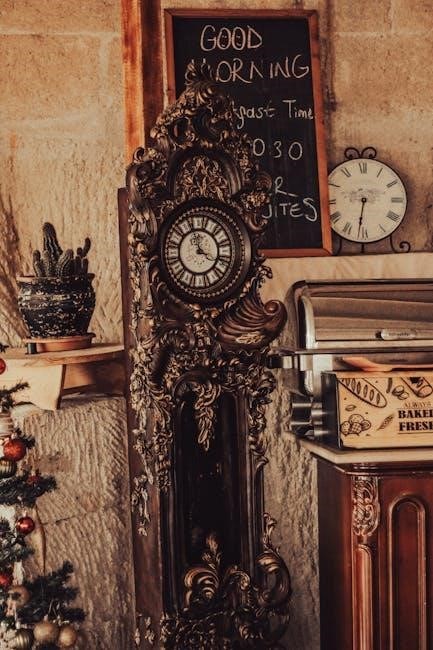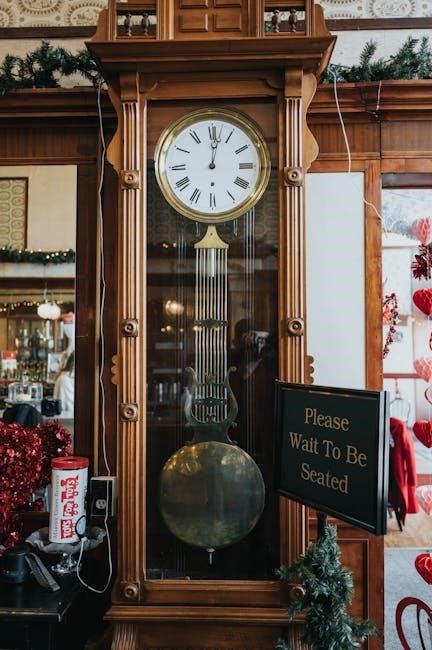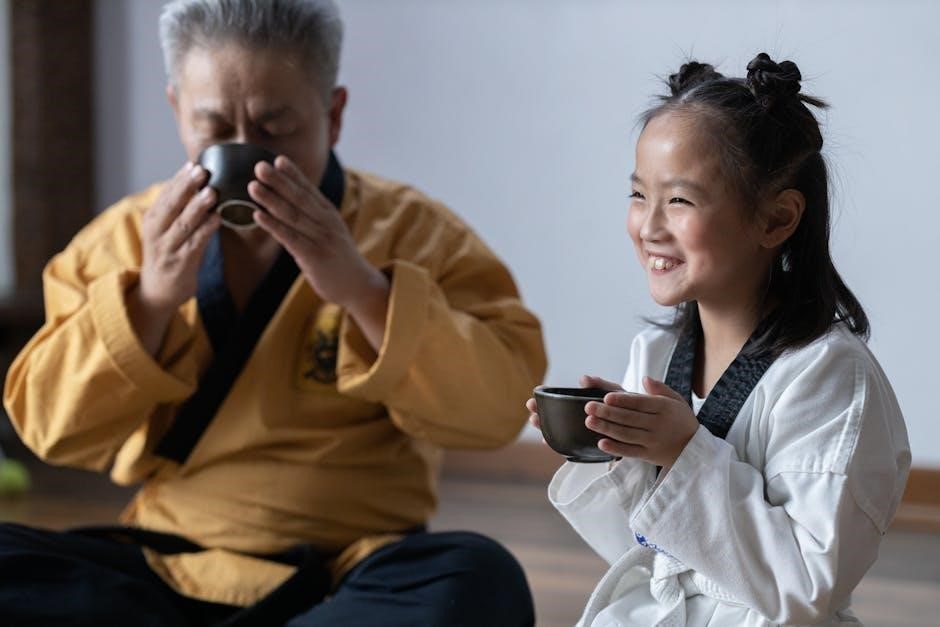Understanding the Value of Your Grandfather Clock

Evaluating your grandfather clock’s value involves considering its maker, age, condition, and rarity. Research the manufacturer, as brands like Sligh or Howard Miller often hold higher value. The clock’s age and operational state are crucial, with functional pieces commanding higher prices. Rare features, such as moonphases, can increase worth. Provenance and expert appraisals further enhance value.
Identifying the Maker
Identifying the maker of your grandfather clock is a critical first step in determining its value. Many clocks bear the signature or logo of their manufacturer, often found on the dial, movement, or case. Look for names like Sligh, Howard Miller, or other reputable clockmakers, as these brands can significantly impact the clock’s worth. For instance, a Sligh grandfather clock with a moonphase feature might be valued between $1,500 and $2,000. If the maker’s mark is unclear or missing, research the clock’s style, materials, and mechanical features to narrow down its origin. Some clocks may also have serial numbers that can be cross-referenced with historical records. Consulting a clock key size chart can also provide clues, as certain keys are specific to particular manufacturers. Experts recommend examining the clock’s craftsmanship, such as the precision of the gears or the quality of the finish, to further identify its maker. In cases where the maker remains unknown, consider seeking advice from a professional appraiser or antique dealer who specializes in clocks. Understanding the maker’s reputation and the clock’s lineage can greatly influence its appraisal and resale value. This step is foundational for accurately assessing the clock’s overall worth.
Assessing the Age

Assessing the age of your grandfather clock is essential for determining its value. Start by examining the clock’s movement, as older clocks often have mechanical components that show signs of wear. Look for dates or patents stamped on the movement, which can provide direct evidence of its age. Additionally, the materials used in the clock’s construction can offer clues; for example, earlier clocks may feature hand-carved wood or brass components, while later models might incorporate more modern materials. The clock’s style and design can also indicate its era, with certain periods favoring specific aesthetic trends, such as Victorian or Art Deco influences.

Check for any historical documentation or records that might accompany the clock, such as receipts, appraisals, or family histories. These can help verify the clock’s age and provenance. If the clock is missing key components, such as weights or keys, it may suggest that it has been altered or repaired over the years, which could affect its age assessment. Consulting with a clock expert or antique appraiser can provide valuable insights, especially if the clock’s age is unclear. Understanding the clock’s historical context and timeline is crucial for accurately assessing its value and ensuring it is placed in the correct market category. Age, combined with other factors like condition and rarity, plays a significant role in determining the clock’s overall worth.
Evaluating the Condition
Evaluating the condition of your grandfather clock is a critical step in determining its value. A well-maintained clock in excellent working condition will generally command a higher price than one that is damaged or non-functional. Start by inspecting the clock’s exterior for signs of wear, such as scratches, dents, or fading of the finish. The case’s integrity is important, as any damage or repairs can affect the clock’s value. Check the dial for cracks, chips, or discoloration, as a pristine dial significantly enhances the clock’s appeal.
Examine the clock’s movement by opening the case. Look for rust, corrosion, or signs of excessive wear on the gears and pivots. If the clock is missing weights, pendulums, or other essential components, its value may be reduced. Additionally, verify that all hardware, such as hinges and door latches, is in good working order. If the clock has been restored or repaired, ensure that the work was done professionally and maintains the clock’s original character.
Turn the clock on to assess its functionality. A smooth, consistent tick-tock sound indicates a well-maintained movement, while irregular noises may signal underlying issues. Missing or damaged parts, such as finials or other decorative elements, should be noted, as they can impact the clock’s overall value. A thorough evaluation of the clock’s condition will help you understand its current state and potential for restoration or resale. This step is essential for setting a fair and accurate value for your grandfather clock.

Considering Rarity and Features
Rarity and unique features significantly influence the value of a grandfather clock. Clocks with limited production runs, exclusive designs, or special mechanisms are often more valuable. For instance, clocks with intricate carvings, ornate details, or rare wood types can command higher prices. Additionally, features like moonphase displays, chimes, or automaton movements add to the clock’s desirability and value.

Clocks with historical significance or ties to notable makers, such as Sligh or Howard Miller, are particularly sought after. The presence of rare components, such as double-end keys or unique winding mechanisms, can also enhance value. If your clock includes original accessories, like weights or a pendulum, it can further boost its worth. Larger or more elaborate clocks, such as those with extended cases or intricate detailing, are often rarer and more valuable than standard models.
Some grandfather clocks feature specialized dials, such as those with astronomical indicators or calendar functions, which are highly prized by collectors. Similarly, clocks with unusual or innovative mechanisms, such as those designed by master clockmakers, can be extremely rare and valuable. The combination of rarity and unique features makes certain grandfather clocks stand out in the market, commanding premium prices from collectors and enthusiasts.
Understanding these factors will help you identify what makes your grandfather clock special and how its features contribute to its overall value. This knowledge is essential for setting a realistic and competitive price when selling or insuring your clock.
Deciding Where to Sell
Deciding where to sell your grandfather clock requires careful consideration to ensure you receive a fair price. Start by getting your clock appraised by a professional to determine its value. Knowing its worth will help you choose the most suitable sales platform.
Online marketplaces like eBay or specialized antique websites can reach a broad audience, but be cautious of potential scams and ensure you use reliable platforms. Specialized auction houses are another excellent option, as they attract serious buyers and often have expertise in antiques. Research reputable auction houses in your area or online.
Local antique dealers may offer a more personalized experience and are convenient if you prefer face-to-face interactions. However, be prepared for lower offers due to their need to make a profit. Consider visiting multiple dealers to compare offers and find one who specializes in grandfather clocks.

Consignment shops can also be a viable option, allowing you to sell your clock through their network of buyers. Ensure you agree on a fair commission rate and understand their sales process. Estate sales or flea markets might be less suitable for a single, valuable item like a grandfather clock.
Selling directly to collectors can yield higher prices, as they may be willing to pay more for a rare or unique piece. Join online forums or specialized groups to connect with potential buyers. However, this method requires more effort to find the right audience.
Consider the logistics of selling, such as the size and weight of the clock, which may make shipping costly. Selling locally can simplify the process and avoid high shipping fees. Ultimately, choose the option that balances convenience, reach, and potential profit to ensure you get the best deal for your grandfather clock.
Improving the Clock’s Value
Improving the value of your grandfather clock involves a combination of restoration, maintenance, and preservation. Start with professional restoration to return the clock to its original condition, ensuring that any work enhances its historical authenticity without over-restoring. Regular maintenance is crucial; clean and lubricate the mechanisms per manufacturer recommendations to keep the clock functioning smoothly and prevent damage.

Polishing the woodwork can enhance the clock’s appearance, but use appropriate materials that align with the wood type and style. Replace any missing or damaged parts with authentic components to restore functionality and value. Avoid significant upgrades that might compromise the clock’s originality, as authenticity is key to its worth.
Document the clock’s history, including restoration and maintenance records, to provide transparency for potential buyers. Highlight any notable provenance, such as ownership history, to add value. Finally, consider an expert appraisal to objectively assess the clock’s value after improvements, aiding in setting a fair price and serving as a selling point.

Using a Clock Key Size Chart
A clock key size chart is an essential tool for determining the correct key size for your grandfather clock, ensuring proper functionality and maintaining its value. The chart typically lists various key sizes, including double-end keys, which are common in antique clocks. By measuring the winding arbor or comparing the keyhole size to the chart, you can identify the right key for your clock.
Using the chart correctly involves aligning the key with the arbor’s diameter and ensuring a snug fit. A poorly fitting key can damage the mechanism, reducing the clock’s value. If unsure, consult a professional horologist to avoid costly mistakes. Proper key use ensures the clock runs smoothly, preserving its condition and appeal to potential buyers.
The chart also helps verify authenticity, as certain key sizes are specific to particular manufacturers or time periods. For example, a Sligh or Howard Miller clock may require unique key sizes. By referencing the chart, you can ensure compatibility and avoid using keys that might harm the clock’s inner workings.

